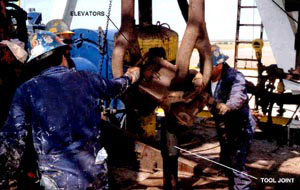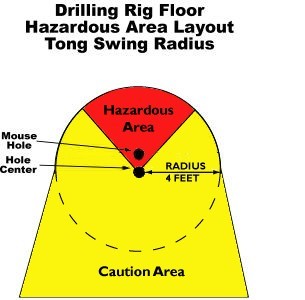|
Tripping refers to the process of removing and/or
replacing
pipe from the well when it is
necessary to change the
bit or other piece of the drill string, or when
preparing to run certain tests in the well bore.
The activities
that comprise tripping out are listed below. Tripping in essentially
comprises the same steps in reverse order.
Additional Information:
- Drilling Technology Series.
Petroleum Extension Service (PETEX), University of Texas at Austin.
- Accident Prevention Guide. International Association of Drilling
Contractors (IADC).
-
RP 54, Occupational Safety for Oil and Gas Well Drilling and
Servicing Operations. American Petroleum Institute (API), (2007, March).
|

Fig. 1. Setting back a stand of drill pipe
|
| Tripping Out |
Tripping In |
|
|
- Elevators raised
-
Tripping In -- Latching Elevators to Top of Stand
- Moving pipe to rotary
- Pipe is made up
- Slips are pulled
- Slips are set
- Elevators are unlatched
- Process repeated for all stands
- Pickup kelly and attach to drill string
- Break circulation, and
- Resume drilling
|
 Setting Slips Setting Slips |

Fig. 2. Setting slips
|
The floor crew sets slips around the drill stem.
Potential Hazards:
- Getting fingers or other body parts pinched between
slips or slip
handles and
rotary table.
- Receiving muscle strain from improper lifting technique.
Possible Solutions:
- Use proper hand placement when setting slips.
- Use proper stance and slip lifting techniques. Slips have three handles and should
be lifted jointly by more than one person.
Additional Information:
- Drilling Technology Series.
Petroleum Extension Service (PETEX), University of Texas at Austin.
- Unit I: The Rig and Its Maintenance
- Unit II: Normal Drilling Operations
- Unit III:
Non-routine Operations
- Unit IV: Man Management and Rig Management
- Accident Prevention Guide. International Association of Drilling
Contractors (IADC).
-
RP 54,
Occupational Safety for Oil and Gas Well Drilling and Servicing
Operations. American Petroleum Institute (API), (2007, March).
Includes procedures for
promotion and maintenance of safe working conditions for employees
engaged in rotary drilling operations and well servicing operations,
including special services. Applies to rotary drilling rigs, well
servicing rigs, and special services as they relate to operations on
locations.
|
 Breaking Out
and Setting Back the Kelly Breaking Out
and Setting Back the Kelly |

Fig. 3. Kelly set into rathole
|
Breakout the
kelly and set it into the
rathole.
Potential Hazards:
- Release of excess drilling mud resulting in skin contact, loss of footing, etc.
Possible Solutions:
- Shut down the
mud pumps before breaking out the kelly.
- Close the mud saver valve on the kelly (if present).
- Use a mud bucket to divert flow of excess mud.
Potential Hazards:
- Being struck by the slip handles if the rotary table is used to spin the drill string.
Possible Solutions:
- Stand clear of the rotary table when it is rotating.
- Consider other technologies (such as a pipe spinner,
kelly spinner, or
top
drive unit) to eliminate this hazard.
Potential Hazards:
- Being struck by the kelly if the pullback line unhooks when kelly is being
pulled toward the rathole.
Possible Solutions:
- Implement an effective pullback line attachment procedure.
- Ensure workers stand in a safe location away from the pullback line and
rathole during this pullback operation.
|
 Attaching Elevators to the Elevator Links Attaching Elevators to the Elevator Links |

Fig. 4. Red elevator links
|
The crew attaches
elevators to
the elevator links.
Potential Hazards:
- Being pinched by the elevator links while attaching elevators (or attaching
elevator links to the hook).
- Being struck by the elevators.
- Receiving strains and sprains.
Possible Solutions:
- Use proper hand placement when attaching elevator links.
- Ensure workers stand away from swing-path of the elevators and elevator
links.
- Use lifting equipment and limit manual positioning of elevators.
- Use proper mounting procedures.
|
 Latching Elevators to Pipe Latching Elevators to Pipe |

Fig. 5. Elevators latched onto the pipe
|
The floor crew latches the elevators onto the pipe.
Potential Hazards:
- Getting hands or fingers pinched in elevators.
- Being struck by elevators not securely latched.
- Getting hands or fingers caught between elevators and stump.
Possible Solutions:
- Ensure workers are instructed in proper latching procedure, including the
use of handles on
elevators as they are descending into place over the stump or tool joint.
- Inspect and maintain elevators.
Additional Information:
- RP 8B, Inspection,
Maintenance, Repair, and Remanufacture of Hoisting Equipment.
American Petroleum Institute (API), (2005, April). Covers such items as crown-block
sheaves and bearings, drilling hooks, elevator links, rotary swivels,
dead-line tie-down/wireline anchors, and safety clamps. This edition of
API RP 8B is an identical adoption of ISO 13534:2000.
|
 Working on the Monkeyboard Working on the Monkeyboard |

Fig. 6. Climbing assist device and
PPE

Fig. 7. Derrickman on monkeyboard

Fig. 8. Handling pipe from monkeyboard
|
The derrickman climbs up the derrick to the
monkeyboard.
From here he unlatches the
elevators and guides the stands of pipe into the fingerboard. The elevators are
then lowered and attached to the next stand of pipe.
Potential Hazards:
- Falling while climbing up or down the ladder.
- Falling from monkeyboard or fingerboard.
- Slips, trips, and falls.
- Falling during an emergency descent.
Possible Solutions:
- Use climb assist device.
- Wear appropriate fall protection including a full body harness. For Fall
Protection guidance, consult:
- Wear the proper
Personal Protective Equipment (PPE) such as:
- Hard hat
- Work gloves
- Safety-toed footwear
- Practice 100% tie-off while working in the derrick.
- Use slip-resistant coatings or materials on working surfaces.
- Train personnel in use of emergency escape device.
Potential Hazards:
- Being caught between pipe and other objects
- Receiving strains and sprains.
Possible Solutions:
- Practice proper hand placement and use of pullback (tail) ropes.
Potential Hazards:
- Being struck by dropped objects.
Possible Solutions:
- Implement a dropped objects program, such as tie-off for all tools.
- Use extra caution while personnel are working overhead.
- Do not carry tools while climbing the derrick ladder. Raise tools with a line to any worker
above the derrick floor.
Additional Information:
-
Fall Protection
- Z359.1. American National Standards Institute (ANSI).
-
Construction. OSHA eTool.
- Fall Protection Guidance. International Association of
Drilling Contractors (IADC).
|
 Breaking
Out Pipe Breaking
Out Pipe |

Fig. 9. Using the tongs to breakout the pipe

Fig. 10. The tong swing radius (illustrated on the drilling floor) is a circular area marking the tong swing radius or four feet from the hole center, adjacent to the mousehole. In red, from the hole center and above in the upper quarter of the circle, is an arc marked as the hazardous area. All other areas are marked in yellow for caution. Only tong operators stand in the tong swing area, all other personnel are outside. No one should stand in the red zone.
|
The crew uses the
tongs
and
cathead to breakout the pipe. The rotary table may be used to spin out
the pipe after breaking the connection.
Potential Hazards:
- Being struck by swinging tongs if they break free from the pipe.
- Being struck by the slip handles if the rotary table is used to spin the drill string.
- Being struck by reverse backlash of tongs (backbiting) during breakout operations.
- Being struck by the tongs if a snub line breaks or the
tongs come unlatched.
Possible Solutions:
- Implement an effective breakout pipe procedure:
- Personnel other than tong operators stand outside the tong
swing radius when breaking pipe.
- No one should stand in the red zone. (see Fig. 10)
- Use proper tong latching techniques and use proper hand and finger placement on tong handles.
- Stand clear of the rotary table
when it is rotating.
- Use special operational procedures when making high torque connections.
- Inspect tong dies and snub lines each tour.
- Maintain good communication between floor hands and driller.
|
 Maneuvering Pipe to Racking Area Maneuvering Pipe to Racking Area |

Fig. 11. Crew maneuvers stand into racking area
|
The stand is raised and maneuvered to the pipe racking area.
Potential Hazards:
- Getting hands and fingers pinched between stands of pipe.
- Getting feet or toes crushed or amputated under a stand of pipe.
- Slips, trips, and falls.
- Receiving strains and sprains.
Possible Solutions:
- Keep hands and fingers from between pipe stands.
- Position feet away from the bottom of the pipe stands.
- See
General Safety.
|
 Tripping
in - Latching Elevators to Top of Stand Tripping
in - Latching Elevators to Top of Stand |

Fig. 12. Derrickman latching elevators onto the pipe
|
The derrickman latches the elevators onto the pipe from the monkeyboard.
Potential Hazards:
- Getting hands or fingers pinched in elevators.
- Being struck by elevators not securely latched.
- Getting hands or fingers caught between elevators and stump.
Possible Solutions:
- Ensure workers are instructed in proper latching procedure.
- Inspect and maintain elevators.
|
|
|
|